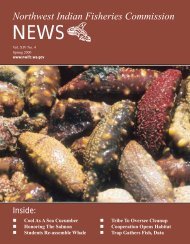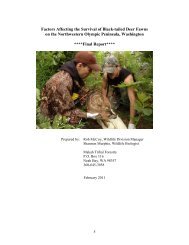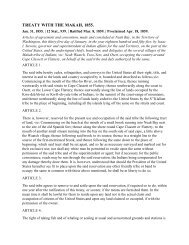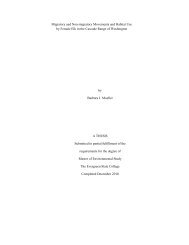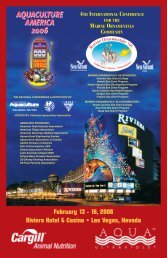Draft TRT Document â for Discussion Purposes ... - NWIFC Access
Draft TRT Document â for Discussion Purposes ... - NWIFC Access
Draft TRT Document â for Discussion Purposes ... - NWIFC Access
You also want an ePaper? Increase the reach of your titles
YUMPU automatically turns print PDFs into web optimized ePapers that Google loves.
<strong>Draft</strong> <strong>TRT</strong> <strong>Document</strong> – <strong>for</strong> <strong>Discussion</strong> <strong>Purposes</strong> – OK to circulateGreen River (Duwamish River)Interpreting historical abundance estimates is more complicated <strong>for</strong> the GreenRiver due to its history of headwater transfers. In 1895, there were 45,900 steelhead(based on average weight of 4.5 kg) harvested in King County, with the Duwamish/GreenRiver being the only major river in the county. (Wilcox 1898). At this time theDuwamish Basin included the Black, Green, Cedar, and White rivers, in addition to theentire Lake Washington and Lake Sammamish watersheds. In 1906, floodwaters andfarmers diverted the White River from the Green River to the Puyallup River.Furthermore, construction of the Headworks Dam (Rkm 98.1) in 1911 on the upperGreen River eliminated access to 47.9 km of river habitat. During the first two years ofoperation an egg-taking station (White River Eyeing Station) operated by the City ofTacoma collected 6,185,000 eggs in 1911 and 11,260,000 eggs in 1912 (WDFG 1913).There were no species-specific egg takes given, other than the 1911 production was fromcoho salmon and steelhead and the 1912 production included Chinook and coho salmonin addition to steelhead (WDFG 1913).The Lake Washington Ship Canal (1916) diverted Lake Washington and LakeSammamish, their tributaries, and the Cedar River directly to Puget Sound. WashingtonDepartment of Fish and Game surveys in 1930, well after the major modifications to thewatershed, identified large steelhead populations in the Green River and Soos Creek(WDFG 1932).Puyallup RiverBased on the harvest in 1909, approximately 30,000 steelhead were harvested inrivers in Pierce County (Cobb 1911). The WDFG 1930 survey found large steelheadaggregations in the Puyallup and Carbon rivers and medium sized aggregations inVoights Creek, South Prairie Creek, and the White River (WDFG 1932). In 1942, in itssecond year of operation, nearly 2,000 steelhead were collected below Mud MountainDam and transported to the upper watershed. Sport fishery catches <strong>for</strong> 1946 and 1947 inthe Puyallup River, averaged 2,846 fish (WDG undated (b)), all of which were presumedto be of wild origin. During the 1949/1950 tribal harvest, 2,176 steelhead were caught inthe White River during January and February.Nisqually RiverRiseland (1907) described the Nisqually Hatchery as having a steelhead “spawn”that is equal to that of most of our large hatcheries. In 1905, 962,000 steelhead fry wereproduced at the hatchery, a production level that would have required several hundredfemale steelhead. Hatchery production continued until 1919, when the hatchery wasdestroyed by floods. At its peak, the hatchery produced 1,500,000 fry in 1912. WDFG(1932) identified the Nisqually and Mashel rivers as having medium sized spawningaggregations. Annual tribal harvest in the Nisqually River from 1935 to 1945 averagedapproximately 1,500 steelhead, and the reported sport catch in the late 1940s varied froma few hundred to a few thousand fish (WDG undated(b)).32



